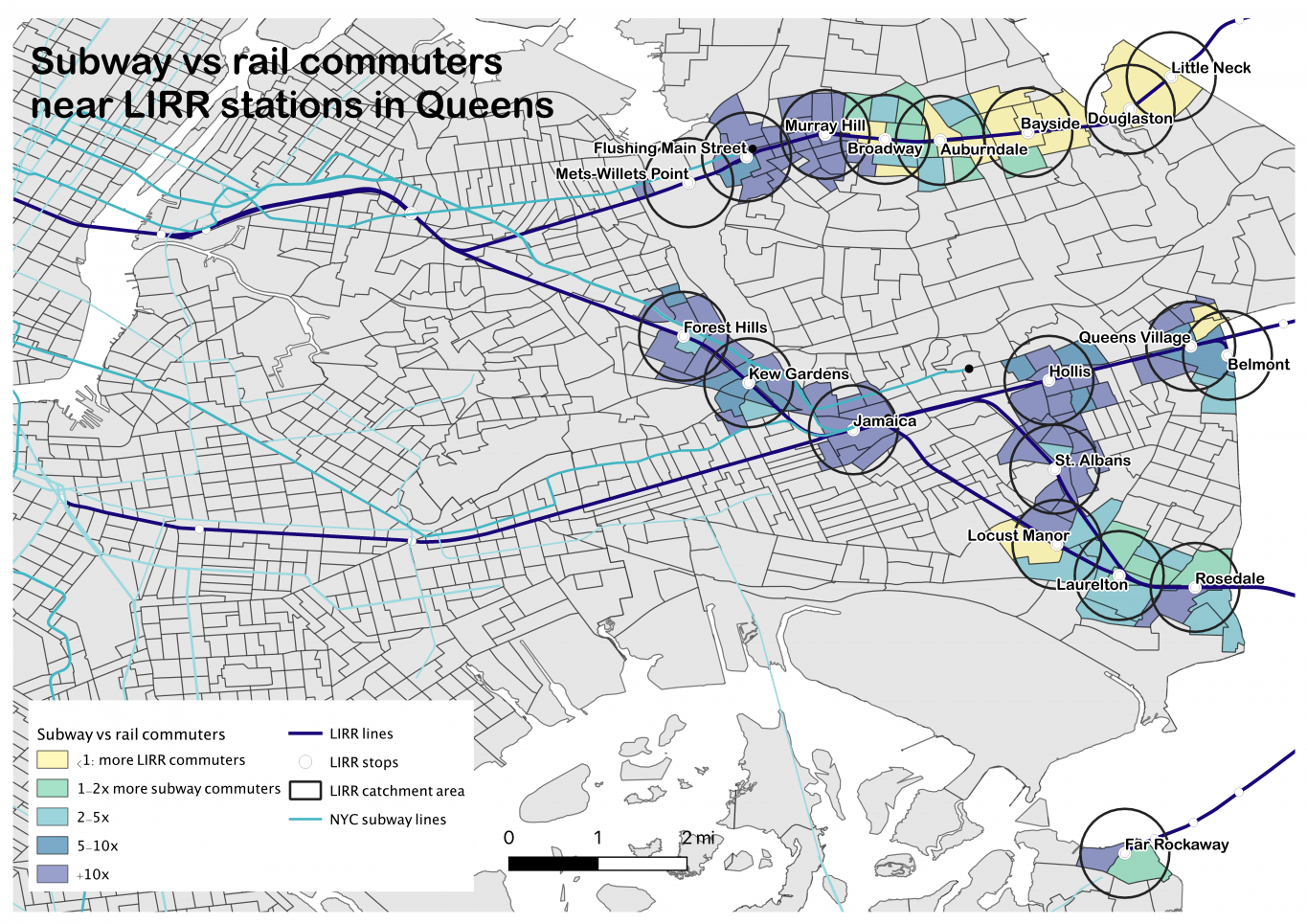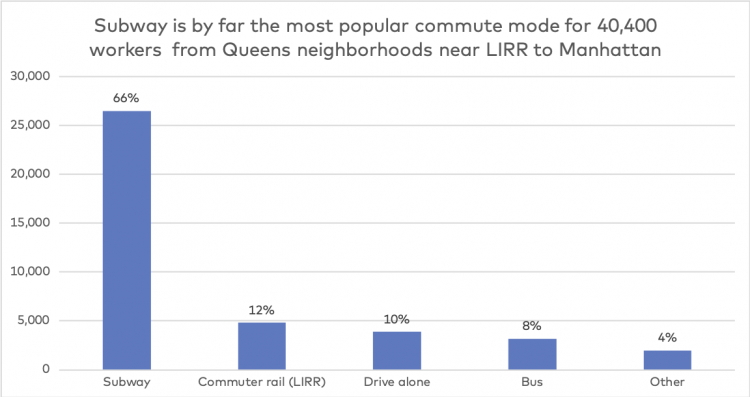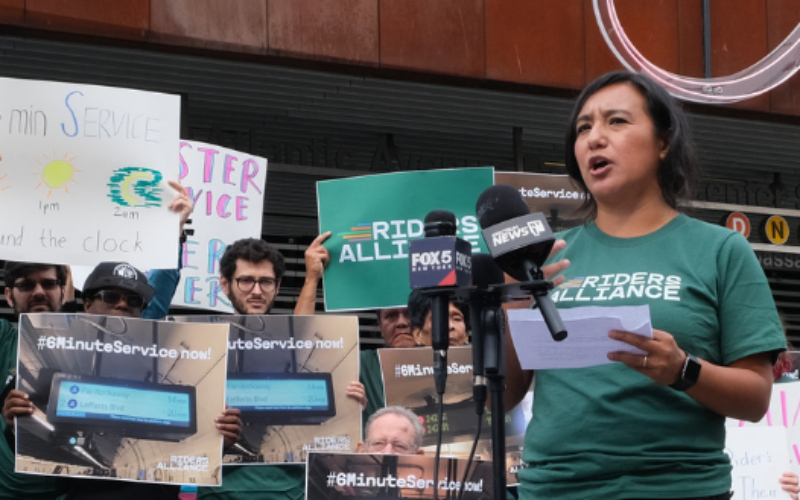
On Wednesday, July 10, TransitCenter is hosting a panel on “Unlocking Access to Commuter Rail” in NYC with Assembly Member Nily Rozic, Council Member I. Daneek Miller, and representatives from City Comptroller Scott Stringer’s office and the Riders Alliance. Join us at the Jamaica Performing Arts Center for a discussion of how to reform LIRR and Metro-North to better serve transit riders.
The Long Island Railroad and Metro-North have dozens of stations in New York City, but for city residents, commuter rail service remains frustratingly inaccessible. A combination of high fares, infrequent off-peak service, and poor integration with other modes of transit make LIRR and Metro-North off-limits even for people who live near these stations.
To get a sense of the flaws in the current system, let’s look at how fare structures discourage LIRR ridership in eastern Queens.
Tens of thousands of eastern Queens commuters can walk to a Long Island Railroad station and get to midtown Manhattan in about 30 minutes. Yet a majority of them forgo LIRR for more time-consuming trips on the subway. Not only do riders lose time, they also cram into overcrowded subways instead of LIRR trains with room to spare.
Of 40,400 workers who live within a half-mile of LIRR stations in eastern Queens and work in Manhattan, two-thirds commute on the subway while 12% take the LIRR, according to a TransitCenter analysis of Census data. (Some of these subway commuters likely take the bus to the subway, or drive and park near a subway station; the Census does not allow respondents to report more than one commute mode.)

Source: TransitCenter analysis of 2012-16 Census data
Even in catchment areas of LIRR stations east of the subway’s reach, many commuters elect to take the subway over LIRR. The disparity is especially large near Murray Hill on the Port Washington Line, and the Hollis, St. Albans, Locust Manor, and Queens Village stations in southeastern Queens — where subway commuters outnumber LIRR riders tenfold. (See map at the top of this post.)
These Queens residents are opting for the subway even though LIRR provides much faster service to Manhattan from eastern Queens. The subway stops much more frequently, and for the 9,000 riders who live beyond the reach of the subway, the commute also requires a bus connection. In Queens neighborhoods east of the subway network, 79% of subway riders have commutes that last an hour or more, compared to 51% of LIRR riders and 35% of commuters overall.
Subway stations and cars are also crowded. According to New York City Transit estimates, the 7, E, and F trains run at or over capacity during peak hours. Riders make 120,000 weekday subway trips that begin or end at the terminal stations on the 7, E, F, and J/Z trains in Queens — 15% of all daily subway trips in the borough. While that means subways are packed far beyond standing-room-only conditions, the average peak LIRR train operates with empty seats, according to LIRR data and an analysis by City Comptroller Scott Stringer.
Price is a huge factor that explains why so many people choose the slower, more crowded option. A subway trip costs $2.75, including transfers — less if you use an unlimited pass — while an LIRR trip from Queens to Manhattan can cost four times as much during rush hour. At that price, the LIRR is a luxury that many Queens residents can’t afford.
It doesn’t have to be this way. In recent years, New York City officials have made the case for commuter rail fares that better serve city residents. The city’s “OneNYC” long-term plan calls for lowering the price of in-city trips on LIRR and Metro-North to $2.75 and allowing for free transfers between commuter rail, subway, and bus routes. Stringer has estimated that doing so would cost just $50 million annually (roughly the same amount that NYC spends operating its new ferry system).
A broader program of lower fares, all-day frequent service, and integration between commuter rail and subway and bus service could unlock enormous benefits for both city and suburban residents.
Such a plan would benefit budget-conscious New Yorkers who are more likely to choose the slower subway commute to Manhattan to save on fares. The average household income of Queens-to-Manhattan commuters on LIRR is over $125,000 per year, $30,000 more than their subway-riding counterparts (according to MTA rider survey data, adjusted to 2019 dollars).
This change in fare policy could alleviate pressure on crowded subway lines as well. If every current subway commuter to Manhattan living near a Queens LIRR station switched modes, that would mean 50,000 fewer passengers per day on the 7, E, F, or J/Z. A less pronounced shift in travel behavior would still have a marked impact on crowding.
Local lawmakers have won partial progress toward this vision. In 2018, after years of advocacy from elected officials including Council Member I. Daneek Miller and groups like the Permanent Citizens Advisory Committee to the MTA, the LIRR launched Atlantic Ticket, a reduced fare for certain trips within Queens and Brooklyn. This year, Assembly Member Nily Rozic announced a deal to reduce the cost of monthly passes from Queens stations on the LIRR’s Port Washington Line.
These preliminary steps have started a conversation about commuter rail reform that will hopefully open the door to more comprehensive changes. A broader program of lower fares, all-day frequent service, and integration between commuter rail and subway and bus service could unlock enormous benefits for both city and suburban residents.
Come to the Jamaica Performing Arts Center on July 10 for the first in a series of TransitCenter events about unlocking access to commuter rail in NYC.
 Built to Win: Riders Alliance Campaign Secures Funding for More Frequent Subway Service
Built to Win: Riders Alliance Campaign Secures Funding for More Frequent Subway Service
Thanks to Riders' Alliance successful #6MinuteService campaign, New York City subway riders will enjoy more frequent service on nights and weekends, starting this summer. In this post, we chronicle the group's winning strategies and tactics.
Read More A Bus Agenda for New York City Mayor Eric Adams
A Bus Agenda for New York City Mayor Eric Adams
To create the “state-of-the-art bus transit system” of his campaign platform, Mayor Adams will have to both expand the quantity and improve the quality of bus lanes. We recommend these strategies to get it done.
Read More